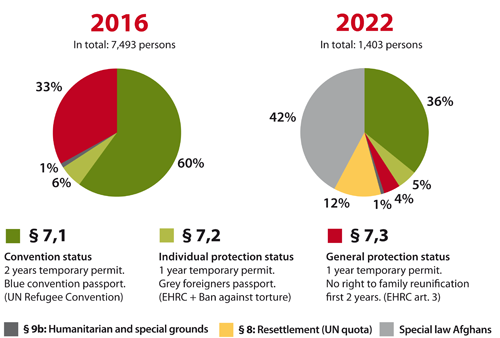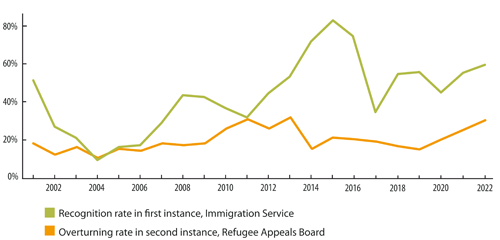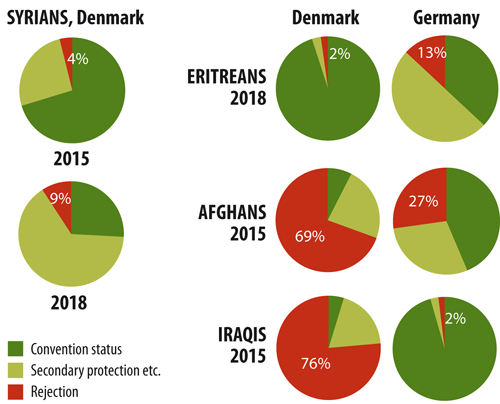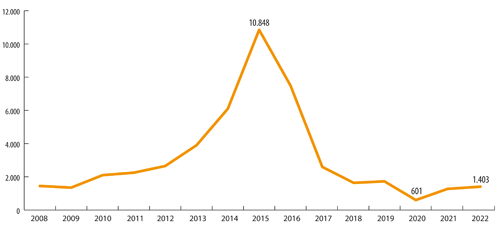What are the chances of being granted asylum?
The success rate (recognition rate) from Immigration Service (first instance) has moved up and down a lot during recent years. In 2015 it reached a record high of 85%, in 2020 it dropped to 44%, and in 2021 it was 59%.
During 2023, 72% of the applicants were granted asylum. However, the percentage includes both newcomers and people who already had a residence permit but applied for asylum later. They are called 'remotely registered' and form between 25-40% of the applicants. Out of the 1,343 who were granted asylum, the municipalities have only received 651 new refugees (besides Ukrainians). During the same period, 48 refugees have had their permits revoked.
Syrians and Eritreans who came via family reunification will almost certainly be granted asylum if they apply, and it gives them a number of advantages. Nearly all of the Afghans who were evacuated and later applied for asylum have also been granted it. These groups affect the total percentage of recognition in first instance significantly.
'Remote registrations' have formed a large part of asylum applications in recent years in Denmark:
2018: 30%. 2019: 35%. 2020: 26%. 2021: 25%. 2022: 7%. 2023: 34% (first 5 months).
Recognition rates for 2023:
Afghanistan: 96%, Syria: 92%, Eritrea: 96%, Iran: 66%, Stateless: 69%
RECOGNITION AND OVERTURNING RATES IN DENMARK 2001-2022
In 2022, 59% were granted asylum by the Danish Immigration Service (first instance), and the Refugee Appeals Board (second and final instance) overturned 26% of the cases they handled. The two numbers cannot be added together, as not all cases go to the Appeals Board and the year might not be the same.
The numbers reflect more than anything else where the applicants are coming from. Almost everybody from Syria and Eritrea are granted asylum all over Europe, and very few applicants from safe countries come to Denmark in general. For that reason, the recognition rate in Denmark seems high compared to EU on average. In the EU, only 39% were granted asylum in 2022, but 50% received a permit if national forms of protection such as humanitarian stay are included. They are rarely used in Denmark.
Since 2016 it has become harder for individual Iraqis, Iranians, Afghans and Somalis to obtain asylum. The same tendency could be seen all over Europe, but Denmark has judged these nationalities much harder than EU on average, see further down this page. In 2021, only 3% of Afghans and 19% of Iranians were granted asylum. After Taliban seized power, the rate for Afghans has risen to over 90%, but most of the Afghan applicants in Denmark were evacuated and thus have a high risk profile. Denmark has recently decided to grant asylum to all women and girls from Afghanistan, which will obviously make the rate stay high.
The chance of getting permission for family reunification afterwards is also depending on which country you come from, though refugees do not have to meet all the criteria. Their obstacles are mainly due to the demands on documents and proofs, which can be hard for many refugees to present. The percentage of positive decisions varied a lot in 2018, depending on country: Eritrea 36%, Somalia 37%, Syria 54%, Iran 73%, Thailand 82%.
RECOGNITION RATES IN DENMARK AND EU 2020
Main nationalities
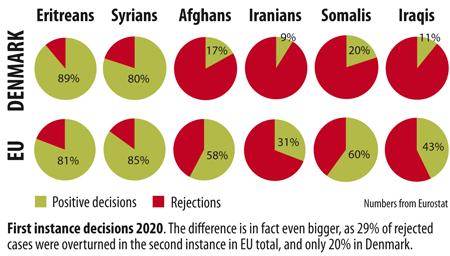
Read more: 'Asylum decisions are influenced by politics' (from 2017)
ASYLUM DECISIONS 2015 + 2018, largest nationalities, certain countries
The pie charts to the left show that Denmark has changed its view on the situation in Syria. The two rows on the right show that Denmark and Germany strongly disagreed on how dangerous the situation was for three of the major refugee groups. The fact that more Eritreans were rejected in Germany might be due to these being first instance decisions. Germany does not return Eritreans.
RESIDENCE PERMITS GRANTED TO REFUGEES 2008-2022 (incl. humanitarian permits, UN resettlement and special law for Afghans)
Which status do you get?
Since 2015, there has been 3 different asylum statuses in Denmark: Art. 7(1), convention status, refers directly to the UN Refugee Convention. Art. 7(2), individual protection status, refers to the other human rights conventions and the ban against torture. And then there is the new art. 7(3), temporary protection against general risk. Resettlement refugees, family reunified and humanitarian permits fall under other articles of the Danish alien act.
When the weaker status 7(3) was introduced, it was given to around one third of all refugees. It's only given to Syrians without an individual asylum motive, and it does not give access to family reunification for the first two years. Proportionally, more women, elderly and unaccompanied minors are given this status.
All three statuses are, however, temporary, only given for 1-2 years at a time and can be revoked again if conditions in the home country improve. Convention status is more difficult to revoke, as this requires a stable improvement.
ASYLUM STATUSES IN DENMARK
